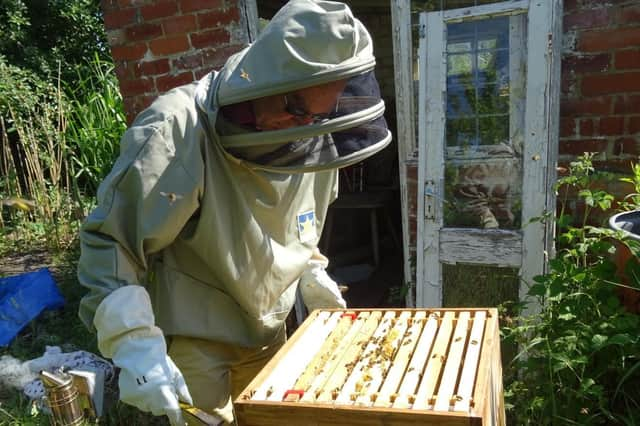A "simple and brilliant" invention which made modern day beekeeping a possibility


Humanity has a long history of taking honey from bees. There are pictures on ancient cave walls showing people climbing cliff faces on rope ladders to cut away honeycomb with furious bees flying around the brave collectors.
When we finally learned to keep bees in more convenient locations it remained an activity that took a huge toll on the lives of the animals. Throughout most of human history the way to keep bees was to put a swarm in a basket or a pottery vessel of the right size, let them build up their strength and then break open the bees’ home at the end of the season to take out the honeycomb.
Advertisement
Hide AdAdvertisement
Hide AdThat killed off the hive and it was necessary to take a fresh swarm again the next season.
All that changed in the 1850s in America with one magnificent discovery.
The Reverend Lorenzo Lorraine Langstroth was cutting into some wild honeycomb when he realised that the bees left gaps within it that enables them to access every hexagonal cell.
They could use corridors between different parts of the honeycomb to move about and the spaces all seemed to be of exactly the same width.
Advertisement
Hide AdAdvertisement
Hide AdSo, he had the brilliant idea of constructing a home for bees that made sure those corridors were in very convenient places.
He built a simple wooden box that allowed moveable frames of bees to be hung inside the box.
Each of the frames was exactly the right distance apart to allow the bees to get between them and work but not so far apart that they would build thick inaccessible layers of wax cells.
That single straightforward idea changed everything. It became possible to look after bees without harming them.
Advertisement
Hide AdAdvertisement
Hide AdIt became possible to harvest honey without killing a single bee and it became possible to study bees working and find out what was going on deep inside their communities.
From that time on domestication of bees took off and beekeeping became a much easier activity. Both for the beekeepers and for the bees.
There was, however, something of a catch. Making things easier changes events in ways that can’t always be foreseen. Once you put bees in a box and guide their activities it becomes possible to set them to work in new ways and that has consequences.
Most amateur beekeepers and the vast majority of small-scale honey producers simply use Langstroth inspired hives to place some bees in a location where there is a good variety of plants that need pollinating.
Advertisement
Hide AdAdvertisement
Hide AdWe use the fantastic invention constructively and provide the bees with a safe and secure home and a good supply of food whilst helping out gardeners and farmers who want crops pollinated.
Things aren’t always the same when it comes to large-scale professional beekeepers who are using the hives to pollinate areas of land where one single crop stretches for miles. Once bees can be housed in neat hives they can also be moved relatively easily.
In Yorkshire this might involve moving hives from a valley bottom to let the bees work the heather on the hillsides for a few weeks.
That will give them a huge boost and let them collect valuable medicinal honey before they return to the valley bottom before winter.
Advertisement
Hide AdAdvertisement
Hide AdIn the United States of America, it involves trucking huge quantities of bees across an entire continent and letting them loose in the Californian almond groves.
Each year millions of hives and trillions of bees are strapped to trucks and driven to a place of work.
Once there the bees eat nothing but one thing for weeks. That weakens them. Then they are put on the trucks and driven off to pollinate the next monoculture crop. By the end of the season the bees are exhausted, lacking in minerals and vitamins and have picked up diseases and parasites from hives brought in from other parts of the country.
Langstroth both liberated well-meaning bee keepers from the need to damage the animals they look after and turned the lives of the vast majority of honeybees in America into a misery of bonded labour. It must be hard to be a great inventor, sometimes even the most harmless and well meaning idea has a downside that could never have been foreseen.
Advertisement
Hide AdAdvertisement
Hide AdOne of the strangest pieces of evidence that proves how long humans have used bees as a source of food is the behaviour of a bird called the honeyguide.
In Mozambique they have discovered humans have developed a call that they use when they go out honey hunting that attracts the bird. The bird also has a special call and accompanies it with displays that encourage the hunters to follow it.
If the humans follow then they are taken to a nest that the bird has spotted. The humans then break open the nest and tear out wax honeycomb dripping with sweet golden liquid.
Once they have collected what they can and start to leave the honeyguide gets its own reward. Lovely juicy grubs and dead bees along with high energy wax and honey.
For the bird and for the humans this represents a massive boost of delicious calories but it leaves the bees with a wrecked nest and the death of an entire colony.